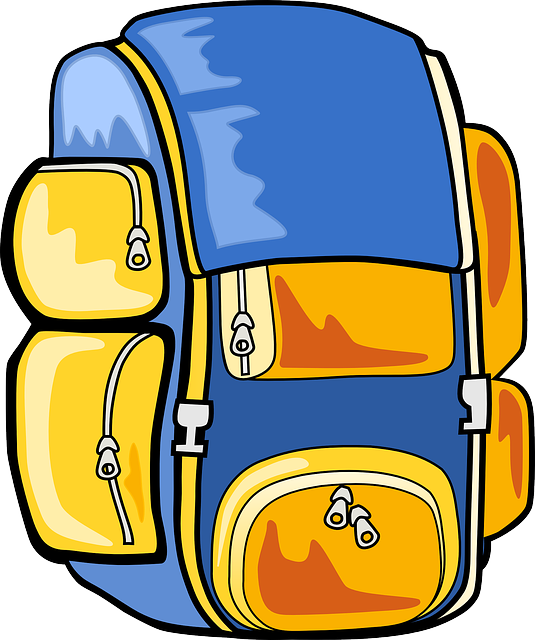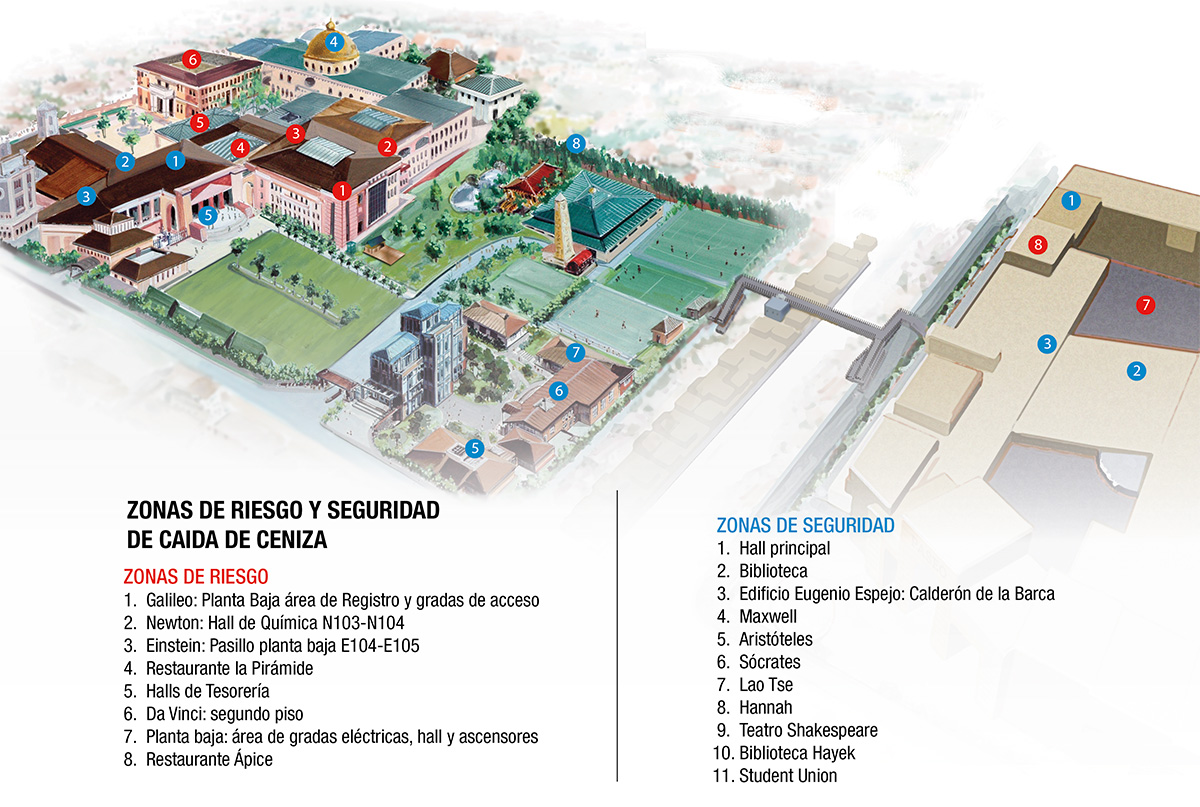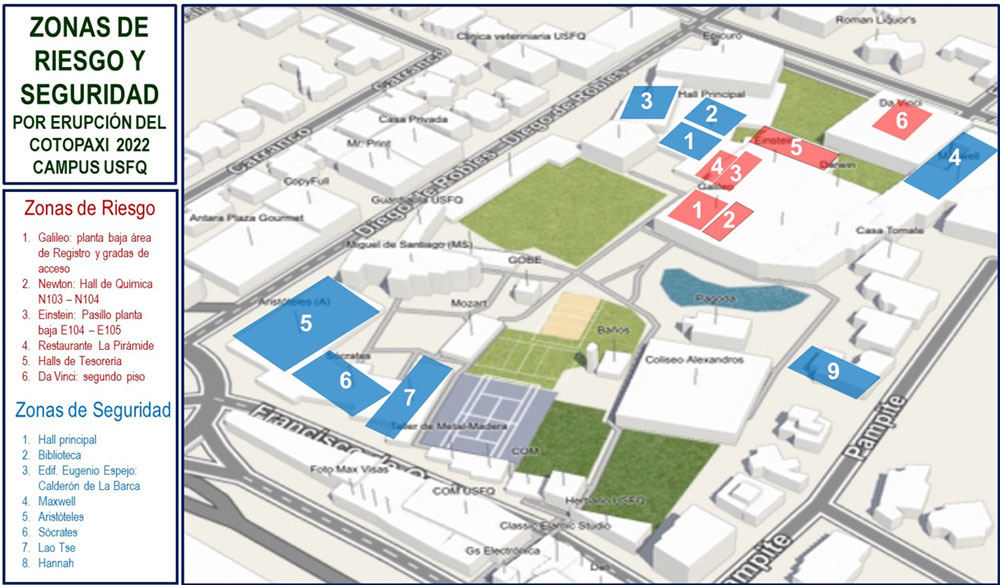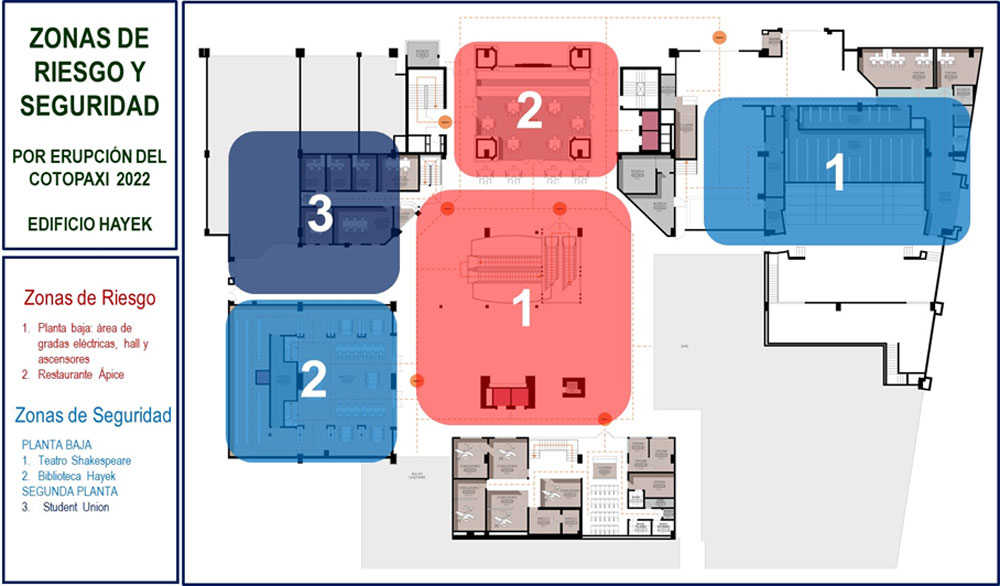Cotopaxi Contingency Plan
In light of the Cotopaxi volcano's reactivation, USFQ has prepared a set of precautions solely for the goal of safeguarding the integrity of the members of our community who are on the Cumbayá campus and at the Hospital de los Valles. As a result, we urge you to take the following actions:
Contingency Plan
On Orange Alert
The Emergency Committee of the University will convene to quickly assess the situation once the official agencies decide to go from alert to orange. The rules established by governmental and municipal authorities, including whether it is possible to stay on campus, will be adhered to.
Unless there is a government decision that specifies otherwise, USFQ operations won't be stopped during the orange alert. The USFQ Emergency Committee will be in touch with the appropriate authorities constantly.
Members of the USFQ community must have an emergency backpack and a Family Emergency Plan when the orange alert is activated and for the duration of this phase.
Backpack for Emergencies
The emergency backpack or suitcase is critical for mitigating potential risks that may arise during an emergency. It is recommended that each person have an individual backpack, which should be kept at the point of contact, in the vehicle, or in the location specified in the Family Plan. Below is a table of items that should be in the emergency backpack:
| First Aid Kit | Toiletries | Equipment/Miscellaneous |
|---|---|---|
| N95 Masks | Soap | Glasses |
| Latex Gloves | Toothpaste | Flashlight with batteries |
| Gauze | Toothbrush | Candles |
| Scissors | Toilet paper | Matches |
| Tape | Antibacterial Gel | Warm clothing |
| Cotton | Sanitary Towels | Blanket |
| Physiological Saline Solution | Food and water for at least 3 days | |
| Band-Aids | Comfortable shoes | |
| Bandages | Can opener or razon | |
| Continuous medication | Copy of keys | |
| Cash |

All members of the community must always carry the following items with them:
- Mask
- Glasses
- 2 bottled water bottles
Family Contingency Plan
The University recommends that students, academic and administrative staff, and workers create a Family Emergency Plan that includes contact information as well as detailed plans for where to go in the event of an eruption. You can also use the Municipality of Quito's template, which can be found at the following link: http://www.quito.gob.ec/documents/plan_familiar.pdf
The National Risk Management Service website contains official information on the meaning of warnings, alarm tones corresponding to the warnings, recommendations and maps of evacuation routes and safe zones. It is recommended that members of the community become acquainted with the information on this page. https://www.gestionderiesgos.gob.ec/volcancotopaxi/
It is also recommended that you identify the safe zones on your daily route. The authorities’ risk map and safe zones can be found at the following link: http://www.quito.gob.ec/documents/mapa_cumbaya_tumbaco_vcotopaxi.pdf
On Red Alert
Stage during the day: from 07h00 to 21h00
If the governmental authorities declare a red alert and do so between 07h00 and 21h00, USFQ operations will be halted. Furthermore, the following policies will be followed:
On campus:
- USFQ alarms will be activated during the transition from orange to red alert.
- On-campus academic and administrative activities will be suspended.
- In the event of an ash fall, wear a face mask in open areas.
- Students, faculty, staff and administrators will be given instructions in the event of an immediate red alert.
- When the red alert is issued, instructions will be given for an orderly evacuation of the university, and the PSF parking lot will be opened for easy evacuation.
- Students, academic and administrative personnel and workers who, due to force majeure, cannot leave the campus, must go to the "Safe Zones" of the USFQ, identified in the "Map of Risk and Safety Zones".



Stage in the evening: from 21h01 to 06h59
If the governmental authorities declare a red alert and do so between 21h01 and 06h59, USFQ operations will be suspended.
On campus:
- USFQ alarms will be activated during the transition from orange to red alert.
- Security and constant monitoring will be strengthened.
- No one is permitted to enter the university because it is closed.
Off-campus scenario: If you are not on campus when a new heightened risk alert is issues or during an eruption:
- If an eruptive event occurs while any USFQ community member is outside the University, authorities’ instructions must be followed, especially if the person is in a risk zone. Any evacuation must be conducted in a controlled and calm manner, in accordance with the instructions of the competent governmental authority.
- If you are close to your home and it is not in a danger zone, it is advised that you return home and stay there.
- If you are close to the USFQ, you should go to the nearest refuge area (provided for in your family plan).
- Follow the plan outlined in your family plan.
Frequently Asked Questions
Unless the municipal, governmental, or Risk Management Secretariat authorities order the cancellation of classes or the interruption of activities, the University will continue to operate on a regular basis. They should be informed via USFQ's institutional mail and social networks. Cars will be able to enter and exit the Paseo San Francisco parking lots normally.
When the alert level is raised to orange, everyone is required to bring their emergency backpack to the university every day.
No, each student must have a personal family emergency plan and will be responsible for finding a temporary home or going to nearby government or municipally designated shelters.
Official communications from governmental and municipal authorities should be communicated to students on a continuous basis. Academic activities will be suspended only if all educational institutions, including universities in the Metropolitan District, are ordered to close; otherwise, the University will operate normally.
The USFQ alarms will go off. Classes will be canceled, and the university community will be evacuated and required to return home or designated space in accordance with their family plans. People will be free to leave at any time.
The entire Paseo San Francisco will be closed, including USFQ classrooms and the pedestrian entrance. Members of the USFQ community will be able to get to the University’s designated "Meeting Points".
While on orange alert, the emergency backpack must be always worn.
The PSF will open the parking lot to allow an easy evacuation.
Yes, but keep in mind that traffic may be backed up and driving is hazardous if ash falls.
No, all USFQ community members must follow the Family Plan.
Do not attend classes and keep an eye out for official University announcements.
- Website, Social Networks
- Billboards
The alarm will sound in both continuous and intermittent tones.
An SMS alert message will almost certainly be received from the Government, USFQ social networks, etc. The Emergency Committee will communicate a change in alert status via social media. Furthermore, this Committee will request that the head of USFQ Security to have both the custodial and cleaning visit each classroom/office and report the change of alert. Megaphones will be used in open areas to provide notice.
Closed safe places: Main Hall, Aristotle, Da Vinci except for the third floor may be used in case of an ash fall.
Open Safe Sites: Courts, Maxwell Plaza, and general parking.
Sites that will remain closed and inaccessible: Galileo (Registration Office area), Treasurer's Hall, Chancellor's Office access steps, Chemistry Hall, CISCO Labs entrances.
HDLV has its own contingency plan. When an evacuation order is issued at the Hospital, students, and staff should follow their familiar plans.
Because it reduces social disasters and chaos. People's uncontrolled reactions cause more problems than natural disasters. A person will feel at ease if they know their family and pets are safe.
When creating the Family Emergency Plan, consider the following scenarios:
- Orange alert at home/orange at work/orange during leisure time.
- Red alert at home/red at work/red during leisure time.
The Office of International Programs OPI has developed its own Contingency Plan which has been communicated to its students directly. Please contact the OPI office located in the Tomato House for more information.
Updated information on vehicular evacuation routes should be obtained through the following link: http://www.quito.gob.ec/index.php/municipio/217-cotopaxi
Official Sources
Always find out through official media.
SERVICIO NACIONAL DE GESTIÓN DE RIESGOS Y EMERGENCIAS (NATIONAL RISK AND EMERGENCY MANAGEMENT SERVICE)
- Web site: https://www.gestionderiesgos.gob.ec/
- Twitter: @Riesgos_Ec
- Facebook: Riesgos Ecuador
- Instagram: @riesgos_ec
INSTITUTO GEOFÍSICO DE LA ESCUELA POLITÉCNICA NACIONAL (GEOPHYSICAL INSTITUTE OF THE NATIONAL POLYTECHNIC SCHOOL)
- Web site: https://www.igepn.edu.ec/
- Twitter: @IGecuador
- Facebook: IGEPNecuador
- Instagram: @igepnecuador
In case of emergencies, call 911
Hashtag: #EntreDragonesNosCuidamos
